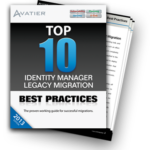October 2, 2014 • Garrett Garitano
You need an Identity and Access Management solution if you deal with P.A.I.N.
Identity and access management manual processes. With all of the publicity around data breaches and information security issues affecting organizations today, I am still amazed to find companies who are willing to maintain antiquated identity and access management (IAM) processes. Maybe upper management simply isn’t aware of the operational and information security issues that exist, […]

With all of the publicity around data breaches and information security issues affecting organizations today, I am still amazed to find companies who are willing to maintain antiquated identity and access management (IAM) processes. Maybe upper management simply isn’t aware of the operational and information security issues that exist, but Identity Management is one area where cost savings and risk reduction are easily realized. In order to help CIOs and other IT decision-makers with security-related project priorities, I thought it would be beneficial to call out four P.A.I.N. points that illuminate glaring issues with identity and access management in organizations.
If you deal with challenges in any of the P.A.I.N. points below, you are exposing your organization to unneeded risk. Definitely, take time to investigate the latest
identity and access management solutions.
- Paper – If paper is used anywhere throughout your access processes, you are definitely behind the times and need to invest in an identity management solution. Faxed requests and paper forms lead to inaccurate requests.
- Audits – Audit issues come in many forms. Time-consuming and manual access certification processes and access-related audit findings are major pain points throughout organizations.
- Inappropriate Access requests – If both users and security admins have no idea what access is needed, inappropriate access is probably being granted. Inappropriate access leads to huge security problems and an inability to perform work.
- No Automation – Manual provisioning takes time and obviously fosters mistakes and delays in granting access.
Paper
Let’s face it. Paper-based processes have been replaced with technology solutions in most aspects of a business. There is no reason paper should be involved in critical areas such as access management. If your organization requires paper forms or faxed requests for access, a serious and immediate review of identity management solutions and processes should occur. Worst case, online forms that accept and store requests in a database would be an improvement over paper-based processes.
Audit
Is your security team or some other team spending excessive amounts of time processing data for access audits? Are spreadsheets involved? Are IT resources performing the audits? If you answered “YES” to any of these questions, the audits are most likely ineffective and wasting valuable resource time. Access Governance tools streamline the access audit process, and they help put audit accountability in the hands of the Business. Rather than expecting IT to know the access requirements of every employee in the company, the “Business” should be accountable for access approvals, not IT.
Inappropriate Access Requests
If users, managers and IT have no clue what entitlements are required for staff to do their job, it is a safe bet that the wrong access is being assigned. Wrong access can lead to two issues:
- Excessive access is being granted that can lead to security incidents –or–
- A worker is given inappropriate access that prevents them from doing their job. This leads to lost productivity.
Effective role mining and access research should be performed to understand the access requirements of functional duties within an organization. Only with an understanding of access requirements can appropriate access can be granted and governed.
No Automation
Manual processes are always prone to errors and delays in processing, which is why technology is typically introduced to address critical manual process deficiencies. Therefore, IAM automation should be top-of-mind for access management because both inaccuracies and delays can dramatically impact an organization. Security breaches, lost productivity and audit issues can all result from the manual processing of access requests. There is no excuse for manual processes in today’s technological world.
To sum up, if you are experiencing P.A.I.N. in your organization, it is time to raise the priority of identity and access governance projects. Implementing identity management software solutions will lower risk, save money, elevate the perception of IT throughout the business, and improve operations. There aren’t many IT projects that can address all of those items at once, so IAM needs to be positioned as a must-do in your strategic plans!
Get the Top 10 Identity Manager Migration Best Practices Workbook
 Start your migration from legacy software with the Top 10 Identity Manager Migration Best Practices Workbook. Use this workbook to think through your information security risk before you transition to next generation identity manager software.
Start your migration from legacy software with the Top 10 Identity Manager Migration Best Practices Workbook. Use this workbook to think through your information security risk before you transition to next generation identity manager software.









